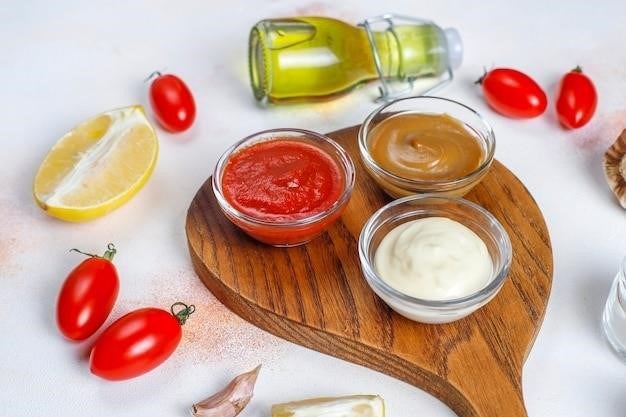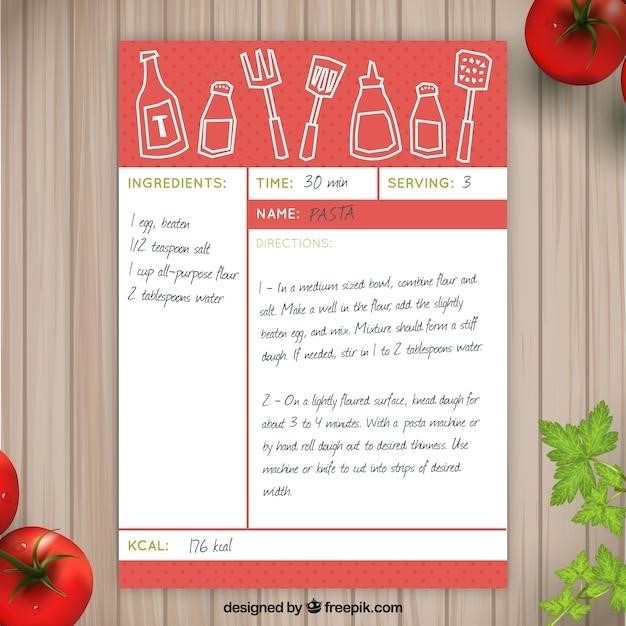
five mother sauces pdf
Five Mother Sauces⁚ A Culinary Foundation
The five mother sauces, originating from French cuisine, were codified by chef Marie Antoine-Carême in the early 20th century, serving as the foundation for all other sauces. In 1833, Marie Antoine Carême published a classification of French sauces in his reference cookbook Lart de la cuisine française au XIXe siècle (The Art of French …
Introduction
In the culinary arts, the term “mother sauce” refers to any one of five basic sauces, that are the starting points for making various secondary sauces or small sauces. They’re called mother sauces because each one is like the head of its own unique family of sauces. Born in 1846, Escoffier was a French chef, restaurateur and
The five mother sauces are the base sauces from which most other cooked sauces are made. By incorporating additional ingredients into a mother sauce, you can create numerous small or compound sauces. Béchamel Sauce⁚ This is a simple sauce to make, which is one of the only mother sauce that does not require a broth base.
The 5 French Mother Sauces⁚ Learn About Béchamel, Velouté, Sauce Espagnole, Sauce Tomat, and Hollandaise Sauce. Written by MasterClass. Last updated⁚ Aug 3, 2021 7 min read. Whether its glazed over a steak, spooned over fresh pasta, or mixed into a soupweve all had a taste of the French mother sauces. The right sauce can elevate …
Five Sauces to Rule Them All⁚ A Good Cooks Guide to the Five French Mother Sauces Moake, Paul on Amazon.com. FREE shipping on qualifying offers. Five Sauces to Rule Them All⁚ A Good Cooks Guide to the Five French Mother Sauces
A. Auguste Escoffiers five mother sauces — hollandaise, béchamel, velouté, espagnole and tomato ‒ are seen as the building blocks of French cuisine. Roux-based, the mother sauces recipes are actually pretty straightforward and with the addition of a few extra ingredients or further reduction you can create any number of daughter sauces …
in Culinary Arts. 16. He didnt realize it when he published them, but Auguste Escoffier left a lifelong culinary legacy when he created the five mother sauces.. They are the basis for virtually every sauce used in modern cuisineand if youre attending a culinary school youre sure to learn them as a foundation for your education.
The Five Mother Sauces
The five mother sauces are the basis of all classical sauces In the culinary arts, the term mother sauce refers to any one of five basic sauces, which are the starting points for making various secondary sauces or small sauces. Theyre called mother sauces because each one is like the head of its own unique family. A sauce is essentially a liquid plus some sort of thickening agent along with other flavoring ingredients. Each of the five mother sauces is made with a different liquid, and a different thickening agentalthough three of the mother sauces are thickened with a roux , in each case the roux is cooked for a different amount of time to produce a lighter or darker color. Here are the five mother sauces and show examples of some of the small sauces that can be made from each mother sauce.
Béchamel sauce is probably the simplest of the mother sauces because it doesnt require making stock. If you have milk, flour, and butter you can make a very basic béchamel. Béchamel is made by thickening hot milk with a simple white roux. The sauce is then flavored with onion, cloves, and nutmeg and simmered until it is creamy and velvety smooth. Béchamel can be used as an ingredient in baked pasta recipes like lasagna, and also in casseroles. But its also the base for some of the most common white sauces, cream sauces and cheese-based sauces. Here are some of the small sauces made from béchamel⁚
Velouté sauce is another relatively simple mother sauce, made by thickening white stock with a roux and then simmering it for a while. While the chicken velouté, made with chicken stock , is the most common type, there is also a veal velouté and fish velouté . Each of the veloutés forms the basis of its own respective secondary mother sauce. For instance, chicken velouté fortified with cream becomes the Supreme Sauce . Veal velouté thickened with egg yolks and cream becomes the Allemande Sauce . And the fish velouté plus white wine and heavy cream becomes the White Wine Sauce . Small sauces from velouté can be derived from the velouté directly, or from each of the three secondary sauces. For example⁚
Béchamel Sauce
Béchamel sauce is probably the simplest of the mother sauces because it doesn’t require making stock. If you have milk, flour, and butter you can make a very basic béchamel. Béchamel is made by thickening hot milk with a simple white roux. The sauce is then flavored with onion, cloves, and nutmeg and simmered until it is creamy and velvety smooth. Béchamel can be used as an ingredient in baked pasta recipes like lasagna, and also in casseroles. But it’s also the base for some of the most common white sauces, cream sauces and cheese-based sauces.
Bechamel sauce, also known as white sauce, uses milk as a base and is thickened with a white roux. Bechamel sauces are commonly flavored with onion, shallots, pepper, or nutmeg. Secondary sauces that are made with béchamel include cheddar cheese sauce, cheese sauce, cream sauces, or Mornay sauce. Bechamel based sauces are often served with …
Here are some of the small sauces made from béchamel⁚
- Mornay Sauce⁚ This is a classic béchamel sauce that is enriched with grated cheese, typically Gruyère or Parmesan. It is often used as a topping for gratins, vegetables, and pasta dishes.
- Cheese Sauce⁚ This is a simple béchamel sauce that is flavored with cheese, such as cheddar, mozzarella, or Swiss. It can be used as a topping for nachos, macaroni and cheese, or as a sauce for vegetables.
- Cream Sauce⁚ This is a béchamel sauce that is enriched with heavy cream. It is a versatile sauce that can be used for a variety of dishes, such as chicken, fish, and pasta.
- Soubise Sauce⁚ This is a béchamel sauce that is flavored with caramelized onions. It is often served with fish or poultry.
Velouté Sauce
Velouté sauce is another relatively simple mother sauce, made by thickening white stock with a roux and then simmering it for a while. While the chicken velouté, made with chicken stock, is the most common type, there is also a veal velouté and fish velouté. Each of the veloutés forms the basis of its own respective secondary mother sauce. For instance, chicken velouté fortified with cream becomes the Supreme Sauce. Veal velouté thickened with egg yolks and cream becomes the Allemande Sauce. And the fish velouté plus white wine and heavy cream becomes the White Wine Sauce.
Small sauces from velouté can be derived from the velouté directly, or from each of the three secondary sauces. For example⁚
- Supreme Sauce⁚ This is a rich and creamy sauce made by adding heavy cream to a chicken velouté. It is often served with poultry, fish, or vegetables.
- Allemande Sauce⁚ This is a classic French sauce made by adding egg yolks and cream to a veal velouté. It is often served with veal, poultry, or fish.
- White Wine Sauce⁚ This is a delicate sauce made by adding white wine and heavy cream to a fish velouté. It is often served with fish, seafood, or poultry.
- Velouté Sauce⁚ This is a basic sauce made by thickening white stock with a roux. It can be used as a base for other sauces, or it can be served on its own with poultry, fish, or vegetables.
Velouté sauce is a versatile sauce that can be used in a variety of dishes. It is a good base for other sauces, and it can also be served on its own. With a little creativity, you can create a variety of delicious velouté-based sauces.
Espagnole Sauce
The Espagnole sauce, also sometimes called Brown Sauce, is a slightly more complex mother sauce. Espagnole is made by thickening brown stock with a roux. So in that sense, it’s similar to a velouté. The difference is that Espagnole is made with tomato purée and mirepoix for deeper color and flavor. And, the brown stock itself is made from bones that have first been roasted to add color and flavor.
Espagnole is traditionally further refined to produce a rich, deeply flavorful sauce called a demi-glace, which is itself the starting point for making the various small sauces. A demi-glace consists of a mixture of half Espagnole and half brown stock, which is then reduced by half. For a shortcut, you could skip the demi-glace step and make the small sauces directly from the Espagnole. You’ll lose some flavor and body, but you’ll save time. Here are some examples of small sauces made from Espagnole⁚

- Demi-Glace⁚ This is a rich, concentrated sauce made by reducing Espagnole sauce by half. It is often used as a base for other sauces, or it can be served on its own with meat, poultry, or fish.
- Bordelaise Sauce⁚ This is a classic French sauce made by adding red wine and shallots to demi-glace. It is often served with beef, lamb, or venison.
- Mushroom Sauce⁚ This is a rich and savory sauce made by adding sautéed mushrooms to demi-glace. It is often served with beef, chicken, or pork.
- Lyonnaise Sauce⁚ This is a classic French sauce made by adding sautéed onions and butter to demi-glace. It is often served with beef, pork, or chicken.
Espagnole sauce is a versatile sauce that can be used in a variety of dishes. It is a good base for other sauces, and it can also be served on its own. With a little creativity, you can create a variety of delicious Espagnole-based sauces.

Hollandaise Sauce
Hollandaise sauce is unlike the mother sauces we’ve mentioned so far, due to a liquid and a thickening agent, plus flavorings. Hollandaise is a tangy, buttery sauce made by slowly whisking clarified butter into warm egg yolks. So the liquid here is the clarified butter and the thickening agent is the egg yolks. Hollandaise is an emulsified sauce, and we use clarified butter when making a Hollandaise because whole butter, which contains water and milk solids, can break the emulsion. Clarified butter is just pure butterfat, so it helps the emulsion remain stable.
Hollandaise sauce can be used on its own, and it’s particularly delicious on seafood, vegetables, and eggs. But there are also a number of small sauces that can be made from Hollandaise⁚
- Béarnaise Sauce⁚ This is a classic French sauce made by adding tarragon, shallots, and white wine vinegar to Hollandaise. It is often served with beef, lamb, or fish.
- Maltaise Sauce⁚ This is a variation of Béarnaise sauce made with orange juice and zest instead of white wine vinegar. It is often served with fish, poultry, or vegetables.
- Choron Sauce⁚ This is a variation of Béarnaise sauce made with tomato ketchup and cayenne pepper. It is often served with grilled meat or fish.
Hollandaise sauce is a classic French sauce that is both delicious and versatile. It can be used on its own, or it can be used as a base for other sauces. With a little creativity, you can create a variety of delicious Hollandaise-based sauces.
Tomato Sauce
The fifth mother sauce is the classic Tomate sauce. This sauce resembles the traditional tomato sauce that we might use on pasta and pizza, but it’s got much more flavor and requires a few more steps to make. First, we render salt pork and then sauté aromatic vegetables. Then we add tomatoes, stock, and a ham bone, and simmer it in the oven for a couple of hours. Cooking the sauce in the oven helps heat it evenly and without scorching.
Traditionally, the tomate sauce was thickened with roux, and some chefs still prepare it this way. But the tomatoes themselves are enough to thicken the sauce. Here are a few small sauces made from the classic tomate sauce⁚
- Provençale Sauce⁚ This is a classic French sauce made by adding herbs, garlic, and olive oil to the Tomate sauce. It is often served with fish, poultry, or vegetables.
- Espagnole Sauce⁚ This is a variation of Tomate sauce made with brown stock and mirepoix. It is often served with red meats, poultry, or vegetables.
- Lyonnaise Sauce⁚ This is a variation of Tomate sauce made with onions, bacon, and white wine. It is often served with eggs, fish, or poultry.
Tomate sauce is a versatile and flavorful sauce that can be used in a variety of dishes. It is a great base for other sauces, and it can also be enjoyed on its own. With a little creativity, you can create a variety of delicious Tomate-based sauces.

